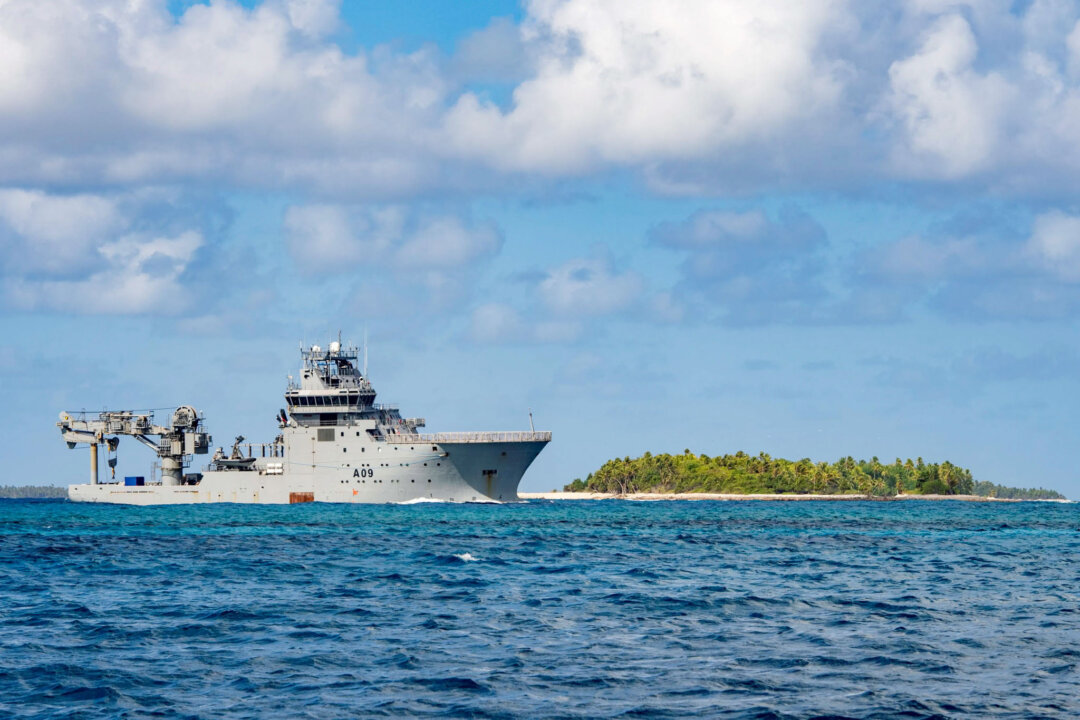Officials in Samoa are assessing the potential environmental impact after the island nation’s prime minister warned that an oil spill is ‘highly probable.’
A New Zealand Navy ship caught fire and has sank off the coast of Samoa, according to authorities.
The incident took place on Oct. 5 while the HMNZS Manawanui was conducting a hydrographic survey about one nautical mile from shore.
At 6:40 a.m. on Oct. 5, the ship was seen listing heavily with smoke visible, and by 9 a.m., it had capsized and disappeared below the surface.
Evacuations began at 7:52 p.m. the previous evening, and all crew and passengers were safely rescued, although some sustained minor injuries, according to authorities in Samoa.
Photos and videos taken from the shore appeared to show the ship listing before disappearing completely below the waves.
The ship, one of only nine in New Zealand’s naval fleet, marks the country’s first naval loss at sea since World War II.
Dave Poole, who witnessed the ship ablaze, told Reuters: “As we came into the bay we saw the ship and no smoke. Within 15 minutes fire and smoke were visible. It sank shortly after.”
Pushing The Life Rafts Toward The Reefs
Rescue efforts for the Manawanui, a specialist dive and hydrographic vessel in service since 2019, near Samoa’s Upolu Island were “particularly challenging,” according to authorities.
“Rescuers battled currents and winds that were pushing the life rafts and sea boats toward the reefs, and swells made the rescue effort particularly challenging,” the New Zealand Defence Force said in a statement.
At this stage the exact cause of the grounding is unknown and will need further investigation.
“We are very grateful for the assistance of everyone involved, from RCCNZ [Rescue Coordination Centre New Zealand] who coordinated rescue efforts, to the vessels which responded and took our crew and passengers from Manawanui to safety,” Maritime Component Commander Commodore Shane Arndell said.
Oil Spill
Officials in Samoa are conducting an environmental impact assessment in the area where the ship sank amid concerns of an oil spill, acting Prime Minister Tuala Tevaga Iosefo Ponifasio said in a statement.
The Samoan Islands archipelago is home to several hundred species of reef-building coral species.
“The HMNZS Manawanui is not recoverable and has sunk into the ocean. The possibility of an oil spill is highly probable,” he said.
New Zealand Defense Minister Judith Collins told Radio New Zealand on Oct. 7 she did not believe that the vessel could be salvaged.
“This is a ship that unfortunately is pretty much gone,” she told reporters, noting that there was “a lot of fuel” on the ship and that efforts had turned to assessing the potential environmental impact.
Aging Military
Concerns over New Zealand’s aging military hardware have sparked warnings from defense officials, with Official Information Act documents revealing that its Navy is struggling to maintain operational capacity amid personnel shortages and outdated equipment.
“[Aging] fleets and cost pressures, combined with problematic global supply chains and decreasing numbers of maintainers and technicians, continue to lengthen repair and maintenance timeframes,” it reads.
“This results in greater mean-times between key equipment and platform availability or no availability at all.”
It states that due to workforce shortages, some vessels were not operational.
The sunken Manawanui—which did not have an organic aviation capability which means that it cannot sail with a helicopter on board—had temporarily taken over the duties of the HMNZS Canterbury, which remains out of service because of workforce shortages following maintenance.
This was HMNZS Manawanui’s third deployment to the South West Pacific this year.
The ship had a series of activities scheduled, including in the Kermadec Islands, Samoa, Tokelau, and Niue.
The vessel was bought by the New Zealand government for NZ$103 million ($69 million) in 2018.
The Associated Press and Reuters contributed to this report.

